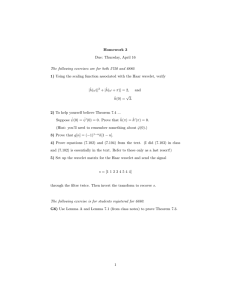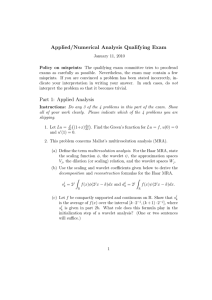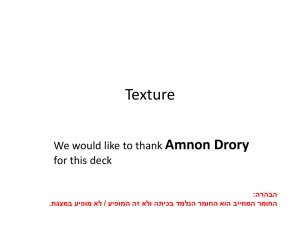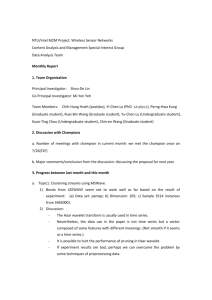An Integrated Texton and Bag of Words Classifier for Identifying
advertisement
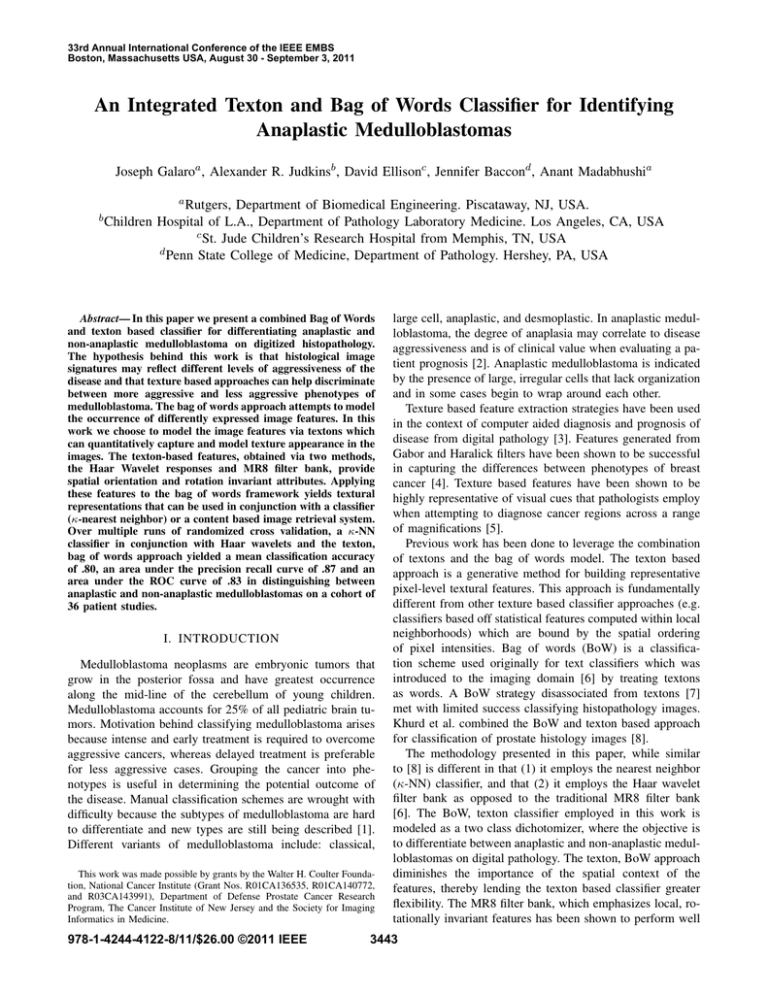
33rd Annual International Conference of the IEEE EMBS
Boston, Massachusetts USA, August 30 - September 3, 2011
An Integrated Texton and Bag of Words Classifier for Identifying
Anaplastic Medulloblastomas
Joseph Galaroa , Alexander R. Judkinsb , David Ellisonc , Jennifer Baccond , Anant Madabhushia
a Rutgers,
b Children
Department of Biomedical Engineering. Piscataway, NJ, USA.
Hospital of L.A., Department of Pathology Laboratory Medicine. Los Angeles, CA, USA
c St. Jude Children’s Research Hospital from Memphis, TN, USA
d Penn State College of Medicine, Department of Pathology. Hershey, PA, USA
Abstract— In this paper we present a combined Bag of Words
and texton based classifier for differentiating anaplastic and
non-anaplastic medulloblastoma on digitized histopathology.
The hypothesis behind this work is that histological image
signatures may reflect different levels of aggressiveness of the
disease and that texture based approaches can help discriminate
between more aggressive and less aggressive phenotypes of
medulloblastoma. The bag of words approach attempts to model
the occurrence of differently expressed image features. In this
work we choose to model the image features via textons which
can quantitatively capture and model texture appearance in the
images. The texton-based features, obtained via two methods,
the Haar Wavelet responses and MR8 filter bank, provide
spatial orientation and rotation invariant attributes. Applying
these features to the bag of words framework yields textural
representations that can be used in conjunction with a classifier
(κ-nearest neighbor) or a content based image retrieval system.
Over multiple runs of randomized cross validation, a κ-NN
classifier in conjunction with Haar wavelets and the texton,
bag of words approach yielded a mean classification accuracy
of .80, an area under the precision recall curve of .87 and an
area under the ROC curve of .83 in distinguishing between
anaplastic and non-anaplastic medulloblastomas on a cohort of
36 patient studies.
I. INTRODUCTION
Medulloblastoma neoplasms are embryonic tumors that
grow in the posterior fossa and have greatest occurrence
along the mid-line of the cerebellum of young children.
Medulloblastoma accounts for 25% of all pediatric brain tumors. Motivation behind classifying medulloblastoma arises
because intense and early treatment is required to overcome
aggressive cancers, whereas delayed treatment is preferable
for less aggressive cases. Grouping the cancer into phenotypes is useful in determining the potential outcome of
the disease. Manual classification schemes are wrought with
difficulty because the subtypes of medulloblastoma are hard
to differentiate and new types are still being described [1].
Different variants of medulloblastoma include: classical,
This work was made possible by grants by the Walter H. Coulter Foundation, National Cancer Institute (Grant Nos. R01CA136535, R01CA140772,
and R03CA143991), Department of Defense Prostate Cancer Research
Program, The Cancer Institute of New Jersey and the Society for Imaging
Informatics in Medicine.
978-1-4244-4122-8/11/$26.00 ©2011 IEEE
large cell, anaplastic, and desmoplastic. In anaplastic medulloblastoma, the degree of anaplasia may correlate to disease
aggressiveness and is of clinical value when evaluating a patient prognosis [2]. Anaplastic medulloblastoma is indicated
by the presence of large, irregular cells that lack organization
and in some cases begin to wrap around each other.
Texture based feature extraction strategies have been used
in the context of computer aided diagnosis and prognosis of
disease from digital pathology [3]. Features generated from
Gabor and Haralick filters have been shown to be successful
in capturing the differences between phenotypes of breast
cancer [4]. Texture based features have been shown to be
highly representative of visual cues that pathologists employ
when attempting to diagnose cancer regions across a range
of magnifications [5].
Previous work has been done to leverage the combination
of textons and the bag of words model. The texton based
approach is a generative method for building representative
pixel-level textural features. This approach is fundamentally
different from other texture based classifier approaches (e.g.
classifiers based off statistical features computed within local
neighborhoods) which are bound by the spatial ordering
of pixel intensities. Bag of words (BoW) is a classification scheme used originally for text classifiers which was
introduced to the imaging domain [6] by treating textons
as words. A BoW strategy disassociated from textons [7]
met with limited success classifying histopathology images.
Khurd et al. combined the BoW and texton based approach
for classification of prostate histology images [8].
The methodology presented in this paper, while similar
to [8] is different in that (1) it employs the nearest neighbor
(κ-NN) classifier, and that (2) it employs the Haar wavelet
filter bank as opposed to the traditional MR8 filter bank
[6]. The BoW, texton classifier employed in this work is
modeled as a two class dichotomizer, where the objective is
to differentiate between anaplastic and non-anaplastic medulloblastomas on digital pathology. The texton, BoW approach
diminishes the importance of the spatial context of the
features, thereby lending the texton based classifier greater
flexibility. The MR8 filter bank, which emphasizes local, rotationally invariant features has been shown to perform well
3443
Pixel Level Features
Texton 1
…
…
Texton 2
Texton Dictionary
Training Only – Map/Model Creation
Training Only - Clustering
Training Image
Pixel Level Features
…
-NN Classification
Testing Only – Map/Model Creation
Testing Image
Fig. 1. Schematic for the construction of a texton based classifier using the Haar wavelet filter bank. The initial features are extracted on a pixel-wise
scale. The features are then clustered via K-means to identify the cluster centroids. The cluster centroids are reflective of the most significant features for
a given class. The feature space representing an image is then reduced to the index of the nearest neighbor texton. The final step is the bag of words tally
of the textons, forming the histogram model for an image. Classification of a new test image involves first constructing the corresponding texton signature
and then using a κ-NN classifier to identify the κ closest database (annotated) images in terms of the L2 norm. The test image is then assigned the class
label of the majority of the closest retrieved instances by the κ-NN classifier.
on synthetic data [6]. However, given that some researchers
have reported less than satisfactory results on histopathology
image analysis [9] it is not clear whether the MR8 filter bank
would be appropriate for disease classification where the
textural differences are often very subtle. Haar Wavelets on
the other hand, in addition to yielding textural features that
the MR8 filter bank is able to capture, also produce textural
responses at different resolutions which are able to better
capture the gradients across the images. This enables the
Haar transform to better account for torosity and misshapen
cells, defining features of anaplastic medulloblastoma. The
novel contributions of this work are:
1) An integrated texton, bag of words scheme which in
conjunction with the Haar filter bank is used for texture
classification, and
2) application of this integrated classifier for an important
prognostic problem in medulloblastomas – namely,
distinguishing anaplastic from non-anaplastic medulloblastomas.
convolving the original medulloblastoma Figure 2(a) with
higher scale filters.
(a)
(b)
(c)
(d)
(e)
(f)
Fig. 2. Illustration of the resulting Haar wavelet images. (a) Original
medulloblastoma image. (b)-(f) corresponding Haar wavelet based texture
representations of the original images obtained by convolving the filter bank
with (a). These images are able to both capture fine features at the higher
scale (b),(c) and macro-transitional features at the lower scale (d)-(f).
II. M ETHODOLOGY
B. Feature Generation
A. Haar Wavelet Filter Bank
The Haar Wavelet Filter allows for image representation in
terms of an orthonormal basis [10]. Wavelet analysis involves
solving for the dot product of a function and a translational
wavelet in order to represent the data as a superimposition of
basis wavelets. In the case of Haar Wavelets, the translational
wavelet is a block function, The process allows for the
formation of an image basis by subtracting the intensity
mean across multiple image pixels. The Haar wavelet filter
bank comprises of wavelets from low to high scales which
when convolved with an image can be used to extract
multi-scale image features. For instance Figures 2(b) and
2(c) represent the finer detail textural images obtained by
We denote an image scene C = (C, f ) where C is an
ordered set of pixels, f (c) is the grayscale intensity at a
pixel c ∈ C, and ` is the corresponding label of the image.
The class label of the image is defined as `(C) = ω, ω ∈
{+1, −1}. The feature space of a pixel consists of the corresponding value in each of 7 Haar wavelet responses, where at
each pixel, the texture based features are denoted by F (c).
In order to account for differences in illumination of the
sample during image capture and outlying filter responses,
we normalize F (c) via the following equation [6]:
|F (c)|
F (c)
log 1 +
(1)
F (c) ←
|F (c)|
0.03
3444
where |F (c)| represents the cardinality of set F (c). After
calculating F (c) at each pixel, the vectors are aggregated into
groups by class in the form Sω = {F (c)|c ∈ C, `(C) = ω}.
C. Creation of Texton Dictionary
The texton dictionary is an aggregation of the centroids
received from K-means clustering on Sω for all ω ∈
{+1, −1}. The steps towards building the texton dictionary
begin by pre-specifying the number of textons per class, K.
Tk,ω is a centroid for a cluster, k ∈ {1...K}, obtained via
K-means clustering of Sω . The texton dictionary is then
defined as the set {Tk,ω |ω ∈ {+1, −1}, k ∈ {1, ..., K}}.
It is important to note that there will only be K textons
per class, because an under- or over-represented class in the
texton dictionary will degrade the classifier.
D. Construction of the Texton Map & Model
Using the texton dictionary created in Section II-C, any
pixel c can be assigned a texton label
h(c) = {k, ω} = argmin kF (c) − Tk,ω k2
(2)
k,ω
based on its nearest texton (via Euclidean distance) in the
feature space.
In this manner, a texton map can be generated for an
image C by finding the corresponding texton label h(c) for
each pixel c ∈ C. Subsequently, a model (i.e. histogram of
texton frequency) comprising K bins for each class can be
constructed to represent each image C via its relationship
with the texton dictionary.
E. Content Based Image Retrieval via κ-NN
For a new image to be classified, the Haar wavelet filter
bank is first convolved with the image and its corresponding
texton dictionary constructed. A κ-NN classifier is then used
to identify the κ closest database (annotated) images in terms
of the L2 norm. The query image is then assigned the class
label of the majority of the closest retrieved instances by the
κ-NN classifier. The strategy is evaluated via classifier accuracy, area under the receiver operating characteristic (ROC)
curve and also content based image retrieval performance
measures such as area under the precision-recall (PR) curve.
III. E XPERIMENTAL R ESULTS AND D ISCUSSION
Haar
MR8
κ
Accuracy
AUC
AUPRC
Accuracy
AUC
AUPRC
3
0.78
0.81
0.85
0.60
0.61
0.70
5
0.79
0.82
0.86
0.59
0.59
0.69
7
0.79
0.83
0.87
0.61
0.61
0.68
9
0.80
0.83
0.86
0.61
0.63
0.69
10
0.80
0.83
0.86
0.62
0.62
0.68
TABLE I
T HE RESULTS OF THE κ OPTIMIZATION USING H AAR WAVELET AND
MR8 FILTER FEATURES . VALUES DISPLAYED ARE ACCURACY, AREA
UNDER THE RECEIVER OPERATING CHARACTERISTIC CURVE (AUC)
AND AREA UNDER THE PRECISION - RECALL CURVE (AUPRC).
A. Dataset
36 labeled histopathological patient studies were received
from the St. Jude Children’s Research Hospital of which,
5 were labeled anaplastic and 31 were non-anaplastic. For
each study the cancerous regions were manually annotated
by an expert neuro-pathologist. Each image is 10000×10000
pixels in size, and was split into 750 individual image scenes
C, each of which are 200×200 pixels in size.
B. MR8 Filter Bank for Comparison
The Maximum Response 8 (MR8) filter bank was employed as a comparative strategy and evaluated against the
Haar wavelet filters to generate the initial texture features.
The MR8 filter bank was generated using a Gaussian derivative function, and by varying the parameters in order to create
a robust set of filters [6]. A total of 4 distinct filters were
applied: 2 isotropic filters, an edge and a line. The filters are
duplicated at three different scales and 6 different rotations.
The rotated sets for each scale of filter are compared and the
largest value becomes the representative response for that
filter at that scale.
C. Quantitative Results
Multiple trials cross validation were conducted to determine the system parameters. The testing set for each
iteration consisted of the image scenes of one anaplastic
and one non-anaplastic patient and the training set was
images scenes of the remaining patients. Clustering the
textons with K-means K = 20 clustering was found to
be optimal for binary classification. From earlier analysis,
it was found that for optimal performance, the value of K
should vary inversely with the number of classes in the
study [6]. Comparing the results by varying the weight of
members in κ-NN classification was implemented to no
effect, so an unweighted κ-NN was used. Table I shows
the corresponding classifier accuracy for the Haar wavelet
based filter in distinguishing between anaplastic and nonanaplastic medulloblastomas. Corresponding values for the
MR8 filter bank are also shown. The Haar wavelet filter bank
outperforms the MR8 filter bank, achieving a classification
accuracy of 0.80 as opposed to the MR8 maximum accuracy
of 0.62. Note also that the classifier statistics are remarkably
consistent over different values of κ for the κ-NN classifier
using the Haar Wavelets, shown in Figure I, yielding a mean
accuracy of .79 and standard deviation of .0068. Additionally
we also evaluated the texton based approach (Haar and MR8)
in terms of (a) area under the precision recall (PR) curve, and
(b) the area under the receiver operating characteristic curve
(ROC). The values obtained were .87 and .83 for the AUPRC
and AUC, respectively, of the Haar wavelet implementation.
The MR8 scheme, however, yielded a AUPRC of .68 and
an AUC of .62, as shown in Table I. An unpaired t-test
was performed under the null hypothesis that there were no
statistically significant differences between the AUC values
for the Haar wavelet and MR8 based classifiers. The null
hypothesis was rejected with a p ¡= 0.0001.
3445
Query
Retrieved
Haar Wavelet Textons
MR8 Textons
Fig. 3. The image patches bordered in red are anaplastic and the image bordered in blue are non-anaplastic. The color of the respective histogram also
reflects the class of the image. The Haar wavelet filters resulted in retrieval of images that were identical to the class label of the query instance, while
the corresponding MR8 filter bank (in this case) was only able to retrieve 1 of 4 instances that matched the class label of the query instance.
D. Qualitative Results
The content based image retrieval in Figure 3 shows for
a given training set and test image, the 4 closest neighbors
retrieved when using Haar wavelets and MR8 filters. Along
with a quantitative analysis, the difference between the
MR8 and Haar Wavelets can be appreciated by viewing
the difference between the nearest neighbors retrieved by
the κ-NN classifier with respect to a query image (Figure
3). The distance between the texton signature of the query
image and different database images is computed via the
L2 norm. The database images with the minimum distance
with respect to the training image are retrieved. Note that
while in the case of the Haar wavelet response, the retrieved
images correspond to the same class of the query images,
fewer images corresponding to the class of the query image
are retrieved in the context of the MR8 wavelet filter bank.
IV. C ONCLUDING R EMARKS
In this paper we presented a texture based classifier
approach for identifying anaplastic medulloblastomas. These
tumors typically have poor prognosis and there is a need
for finding less invasive, cheap prognostic strategies for
identifying them. By using a rotationally invariant filter
bank in conjunction with the bag of words architecture,
the problems associated with attempting macro-geometric
feature based classification are avoided. By using textons to
generate features, local spatial properties are the driving force
behind the classification scheme. Many differences between
anaplastic and non-anaplastic medulloblastoma are limited to
cellular characteristics, explaining the success of leveraging
local texture features in this classifier. The texton-based bag
of words approach in conjunction with the Haar wavelet
filter bank allowed us to achieve a classification accuracy of
0.80 in distinguishing between anaplastic and non-anaplastic
medulloblastomas. The results were found to be superior to
a MR8 filter bank based texton classifier. In future work we
intend to validate our approach on a much larger data cohort.
R EFERENCES
[1] D. Ellison, “Classifying the medulloblastoma: insights from morphology and molecular genetics,” Neuropathology and Applied Neurobiology, vol. 28, no. 4, pp. 257–282, 2002.
[2] C. G. Eberhart, J. L. Kepner, P. T. Goldthwaite, L. E. Kun, P. K.
Duffner, H. S. Friedman, D. R. Strother, and P. C. Burger, “Histopathologic grading of medulloblastomas,” Cancer, vol. 94, no. 2, pp. 552–
560, 2002.
[3] A. Madabhushi, S. Agner, A. Basavanhally, S. Doyle, and G. Lee,
“Computer-aided prognosis: Predicting patient and disease outcome
via quantitative fusion of multi-scale, multi-modal data.” Computerized
medical imaging and graphics, 2011 Feb 16 2011.
[4] S. Doyle, S. Agner, A. Madabhushi, M. D. Feldman, and
J. Tomaszewski, “Automated grading of breast cancer histopathology
using spectral clusteringwith textural and architectural image features,”
in ISBI, 2008, pp. 496–499.
[5] S. Doyle, M. Feldman, J. Tomaszewski, and A. Madabhushi, “A
boosted bayesian multi-resolution classifier for prostate cancer detection from digitized needle biopsies,” Biomedical Engineering, IEEE
Transactions on, vol. PP, no. 99, p. 1, 2010.
[6] M. Varma and A. Zisserman, “A statistical approach to texture classification from single images,” International Journal of Computer Vision,
vol. 62, no. 1–2, pp. 61–81, Apr. 2005.
[7] J. C. Caicedo, A. Cruz, and F. A. Gonzalez, “Histopathology image
classification using bag of features and kernel functions,” in Proceedings of the 12th Conference on Artificial Intelligence in Medicine:
Artificial Intelligence in Medicine, ser. AIME ’09. Berlin, Heidelberg:
Springer-Verlag, 2009, pp. 126–135.
[8] P. Khurd, C. Bahlmann, P. Maday, A. Kamen, S. Gibbs-Strauss,
E. Genega, and J. Frangioni, “Computer-aided gleason grading of
prostate cancer histopathological images using texton forests,” in
Biomedical Imaging: From Nano to Macro, 2010 IEEE International
Symposium on, april 2010, pp. 636 –639.
[9] A. Basavanhally, S. Ganesan, S. Agner, J. Monaco, M. Feldman,
J. Tomaszewski, G. Bhanot, and A. Madabhushi, “Computerized
image-based detection and grading of lymphocytic infiltration in
her2+ breast cancer histopathology.” IEEE transactions on bio-medical
engineering, vol. 57, pp. 642–53, 2010 Mar 2010.
[10] Z. Struzik and A. Siebes, “The haar wavelet transform in the time
series similarity paradigm,” in Principles of Data Mining and Knowledge Discovery, ser. Lecture Notes in Computer Science, J. Zytkow
and J. Rauch, Eds., vol. 1704. Springer Berlin / Heidelberg, 1999,
pp. 12–22, 10.1007/978-3-540-48247-52.
3446
